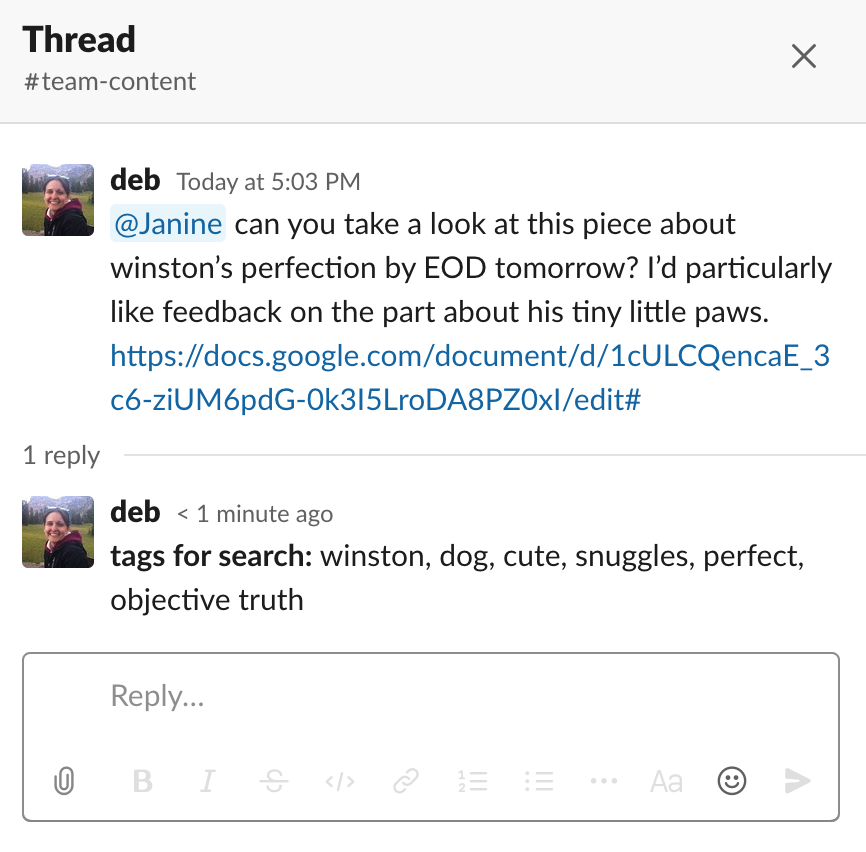At Zapier, our "default to transparency" value means that we communicate in public channels, share information, document our work, and ask questions in a way that helps others do their work more effectively. Emphasis on in a way that helps others do their work more effectively. If you miss that part, it's chaos.
In an effort to make sure no one is out of the loop on a distributed team, it can be easy to double down on sharing information—to the point that no one can find anything. Or get their work done. Or breathe.
We're not immune to that at Zapier. Slack posts saying "I've looked everywhere and still can't find..." happen on the regular. But after almost a decade of working remotely, we've come up with some communication strategies that help curb the overload.
New to remote work? Try these remote work automations that can help you automate the repetitive things and focus more on the human side of communication.
1. Be specific
When you work from home, Slack can get really busy, really quickly. No one can read every message (please don't try), so you need to be specific.
Who are you talking to? What do you want them to do? By when? When you post on Slack—or any other internal tool—tag a particular teammate or group so it will catch their eye. Also, be clear about what information you're looking for.

For example, instead of sending a message that says, "Hey, would you guys mind giving me some feedback on this thing I wrote?" try writing, "Hey @Tom @Danielle, would you mind leaving comments on this Google Doc by EOD tomorrow? Specifically looking for comments on XYZ aspects."
2. Get to the point
Treat your audience's time as more valuable than your own. Help people find answers quickly by putting your main ideas first. Remove unnecessary content and provide links (if necessary) for more context.
For example, your weekly update header might say something like "finalized plans for X project, met with 8 engineer candidates" instead of low-calorie statements like "another busy week!"

On Slack, this means presenting the quick take first and then starting a thread with the rest of the information. Anyone who wants to read the thread can dive in, but anyone who's just scanning the channel won't have so much to wade through. At Zapier, we use a thread emoji (like this: 🧵) to indicate that there's more relevant information in the thread.
3. Eliminate jargon and acronyms
Some of your readers will be brand new to your company—or part of a totally different team. Make an effort to explain jargon or acronyms the first time you use them in a given communication. Not only is it considerate, but it also eliminates the need for someone to ask "what on earth is ZAM?" which only clogs the communication.
4. Use #hashtags to communicate more clearly
This is one our CEO borrowed from Dharmesh Shah at HubSpot. It's a way to categorize what kind of communication you're offering.
#fyi – If you just want to let someone in on something you thought of or saw, use #fyi. It's not even a recommendation yet because, honestly, you probably haven't even thought it through all that much.
#suggestion Use this one if you're letting someone know what you would do if you were in their shoes. They might do it a different way, but at least they know what you think.
#recommendation (or #strongrecommendation) – This one's for when you've really thought through something and are pretty confident your way is the right way. If someone uses this, it's probably time for a discussion if you disagree.
#plea – Use this one if you're basically begging someone to do something a certain way—or do it at all. As Dharmesh puts it, "Dying on a hill is not on my bucket list, but if it were, this would be a really good candidate."
5. Make your communication searchable
One benefit to talking publicly is that your conversations will be very searchable. When you have a question or need context, instead of adding more to the already busy Slack, take a few minutes to search.
On the other side of things, it helps to think like a future searcher when posting content of your own. Where will they search? What words will they use? In fact, if you're communicating something you know people will need in the future, consider keyword stuffing. You can do that in any app, even one that doesn't support tags. For example, after finishing a Slack message, type *tags for search*: [keyword 1, keyword 2, keyword 3]. That way you get your keywords in, but everyone knows why you're doing it.

Of course, you need to post your content in the place that makes the most sense. This will depend on the tools your company uses, and it might mean posting cross-links in several mediums.
Bottom line: don't conflate transparency with telling everyone everything all the time. Be intentional about your communication, and everyone will be much more productive while working from home.






